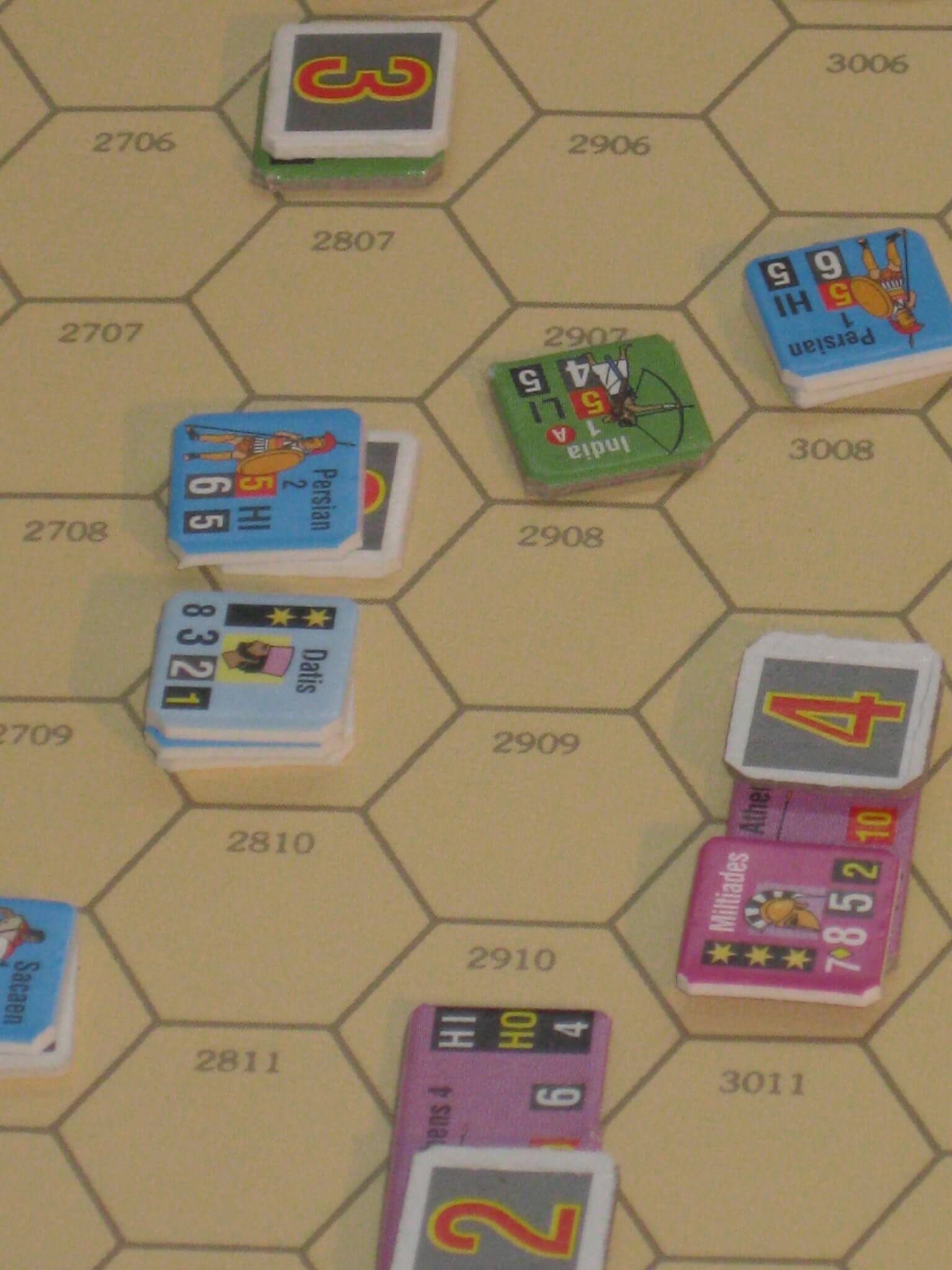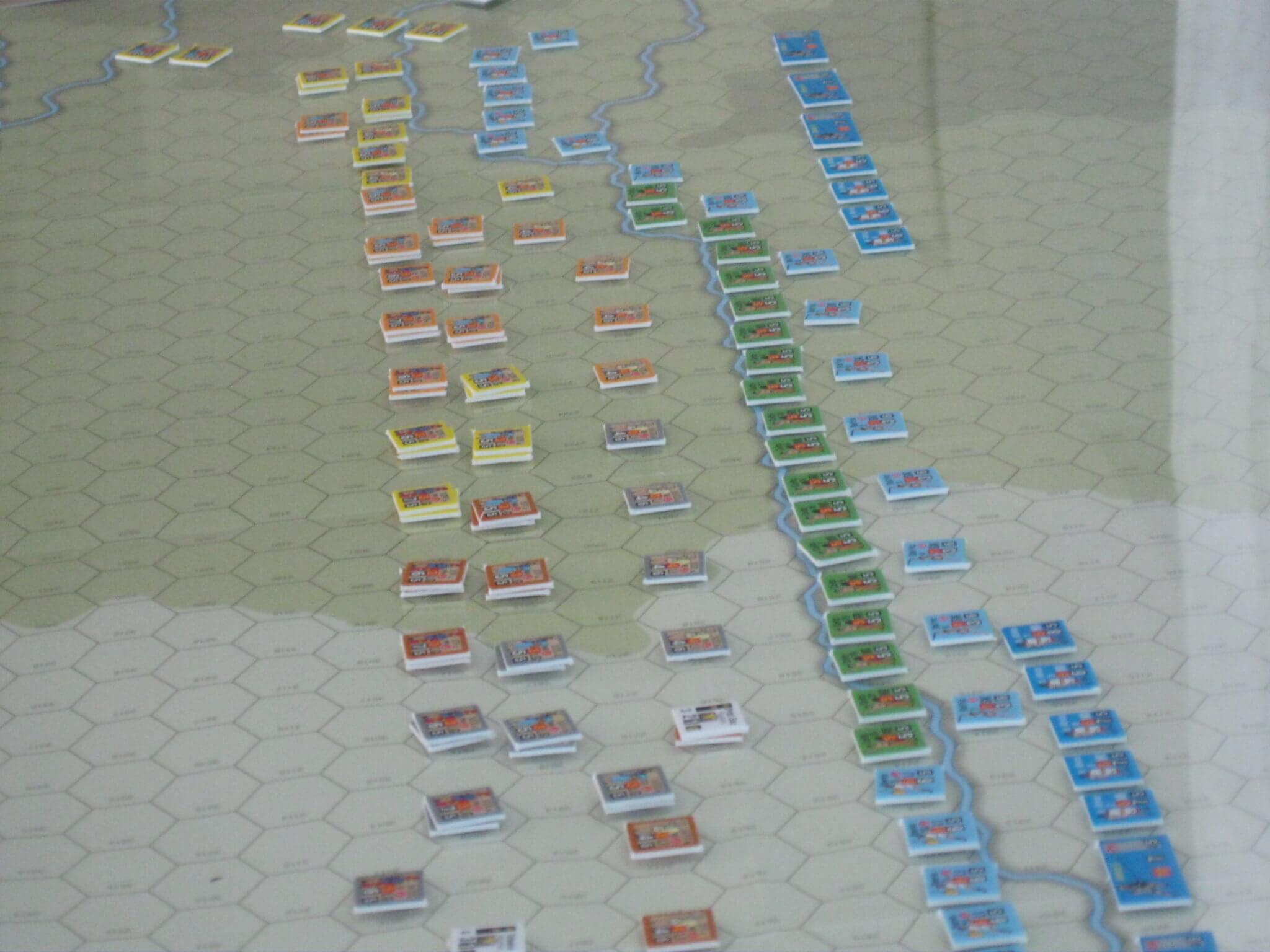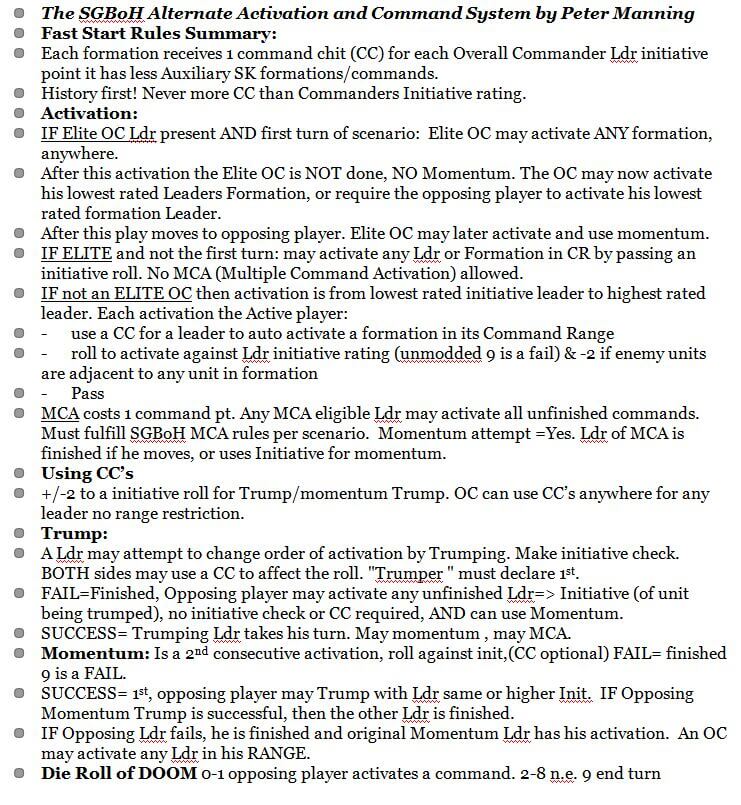It is true Grognard friends and not too hard to guess that over time I’ve found the extra chits, the clutter and wristage of Great Battles of History (GBoH) to be wearying. Many have avoided the system for similar gripes. Whilst a gripping narrative unfolds, (I swear you can hear the trumpet clarion, the dusty thunder of hooves and loud clash of spears) the drama is a drawn out affair. If there were a way to pay homage to the Ancients in such fabulous detail but be done in the time it takes to play a Men of Iron (MoI) Infidel scenario wow! Now that would be something.
Back before I re engaged with examining history via the board game medium, GMT decided to release a system that would unify and simplify the awesomeness of GBoH to allow mere mortals with less luxury time to experience GBoH but in a format that streamlined play without forsaking the essence of Ancient cut and thrust combat.

The game would play the same, but in less time, with less clutter and a simplification and clarification of many of the over wrought rules of play. Sounds wonderful!
However the attractiveness of the SGBoH (Simple Great Battles of History) is tarnished by a activation system that departs rapidly from the excellent GBoH command approach. The approach in GBoH balances the notion of elite leaders, line leaders, and the less skilled generalship wonderfully with the idea that all leaders would be activated and moving in initiative rating order subject to Trumping or seeking Momentum. Two concepts that demonstrate the ability of the Elite leader to act before his lower subordinated leaders and perhaps even before his opponent.
Some of this is lost in SGBoH, and in fact battles tend to exhaust themselves in one section of the battle field whilst the rest of the army languishes. Even with a restriction upon the number of consecutive actions a formation may take the SGBoH version just did not FEEL like Great Battles of History!
Thus a wonderful system that streamlined the play, captured the essence of Ancient combat and drove a consistency across nearly a dozen titles yet was lost to us for some unknown reason, due to a half hearted revision of Activation and Command. From the Plains of Marathon,

to the Edge of the Steppes. We have the potential to use one set of rules! Allow me to repeat that….

We could use one set of rules for eons of battles! The odd tweak here and there, a special rule or two, but all of Ancient History was laid bare and accessible. I for one saw the power of this and as an experiment started playing thru the entire 2nd Punic War! HERE . This needs to be addressed!
So what to do? The activation system really was bothersome, and after an attempt with a friend to play thru all of Alexanders ancient battles using it, we saw that the flaw really was dramatic. Some period of time has passed since the release of SGBoH and new systems from Berg/Herman and Ray have been released. The one that comes to mind is Men of Iron (MoI). Here perhaps is the clue that we seek to the elegance that was missing from SGBoH. Infidel is a close cousin to the late series modules of Cataphract and The Devils Horsemen. Similar arms, and weapon systems, powerful cavalry, a diminished role for Infantry.
Seeing similarities is not too difficult. Combat, movement and activation were radically streamlined for the 2nd title from Men of Iron. Lots of factors are abstracted, but you still captured period flavor.
Activation in MoI’s Infidel was an easy affair, continue attempting to activate adding one to a die roll for each cumulative activation. If you failed a roll against your leaders rating play and a free activation were awarded to your opponent. The concept of Seizure of turns was present, and higher rated leaders could do more.
Not the same as GBoH’s system by any means but a marked improvement over SGBoH. Would this work in SGBoH for any of the periods? I decided to test that out.
GBoH has some unique differences in formations that we must respect. Auxiliaries, skirmishers, Elephants, and typically a lot more lower rated leaders, where the disparity between an Elite Leader and a Tribune for example could be by a factor of 7 points (Tribune 2 v Punic Ldr 9)! After a few abortive attempts at Hodge Dodge rules I realized that rule and game design were best left to other more skilled folks. That system could be applied but not without some designer effort.

I turned to my last source of inspiration – Peter Manning. Some time back I had helped him test his ideas about SGBoH and keeping the full flavor and maturity of GBoH activation in an otherwise good set of simplified rules.
Peter sums it up best:
- A similar mode to GBoH sequential activation.
- A richer playing experience for SGBoH that more accurately reflects what happened on the battlefield and closer to the exciting GBoH activation design.
- A familiar command chit concept that allows leaders to influence activation beyond SGBoH seizure.
- The die roll of Doom! Really how can you miss this in SGBoH?
- Hard choices over whether to spend command points to ensure first activation or save them to try and influence momentum and trumping opportunities with other commands later in the turn.
- A system of activation that creates even more game tension because although activation of all your formations is possible it is not a certainty. This is especially so in larger armies led by weaker Overall Commanders.
- Provides a means of ensuring Skirmish formations active more often without distorting gameplay.
- Incorporates the excitement of Multiple Command Activation into a leader initiative rating system of activation.
- An approach that really comes into its own in larger battles through even harder choices over how best to spend those command points.
- Formations that have ferocity find gaining momentum easier.
(Taken from a letter to C3i )
So it is without further ado that I present to you this wonderful addition to the SGBoH/GBoH universe in summary format. I took the liberty of editing down Peters rules for this post to enable it to be briefly consumed. A full and complete version may be had by simply posting here on the blog and I will email you a copy directly.
Well what are you waiting for. Go grab a cheap copy of Alexander the Great Deluxe or SPQR and the Battle Manual and have it my friends! 500 years of ancient conflict awaits you.


Can I have a copy?
Link doesnt work
msg sent to you.
I’m not sure I completely follow, but it sure sounds interesting, and I’d love to take a closer look!
I’d like to say I’m impressed by your visual AARs and I’m sure it draws some new players into gaming. I started playing GBoH back in October 2011 and initially tried SGBoH as, like you, I wanted one set of generic rules. I found I much preferred the command and control system in GBoH – momentums and trumps – and I also like the detail too. Granted, GBoH takes a while longer to play than SGBoH, though once you get used to the main GBoH system you can play smoothly and enjoy the richness of the simulation. The smaller GBoH scenarios can be played in two to three hours. If I’m playing a big battle, I’ll either leave it set up or when space is limited or I can’t get a ftf game, play via skype on VASSAL, which is great. We just divide a big battle up into two or three GBoH sessions. In the end, it’s a matter of taste. Keep those visual AARs coming (though I’d like to see some main GBoH ones too!).
Firstly thanks for the compliments. I’m glad you enjoy them. I enjoy making the videos and writing the AARS, it adds something for me.
As far as GBoH is concerned yes you are right. The momentum, trumping and breadth of play across the entire battle field is excellent. I had attempted to mess with variations of the GBoH command system as I find the SGBoH system wanting in that regard.
In the end I simple elected to use the GBOH leadership and command system. All of the other guff (as Mark Walker from LNL Publishing likes to put it) was not as necessary. So the rest of the system I use SGBoH play rules and GBoH command.
Quiet a dogs breakfast.
I’m currently playing thru all of Pompey and Caesars battles and contrasting the 2 styles.
Happy Gaming.